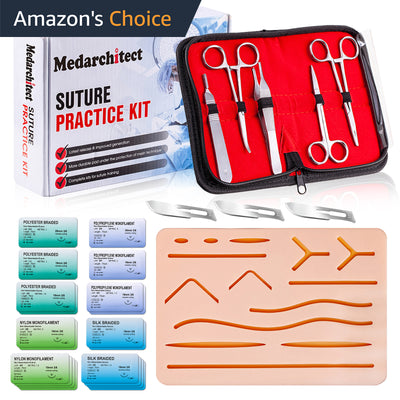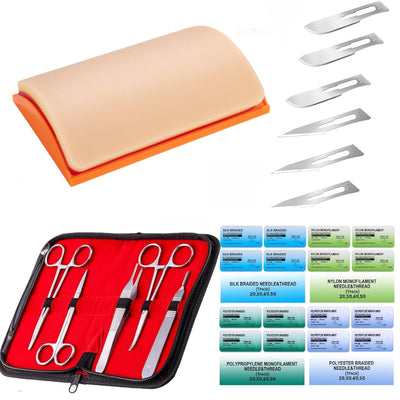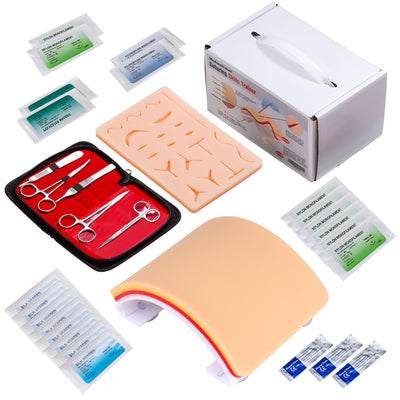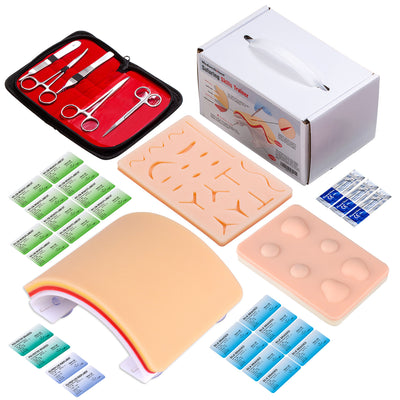The following knowledge is shared by an outstanding surgeon, hoping to help some students who are new to surgery.
Why do people stitch up wounds? The most common reasons for stitching are:
- The wound is too big to heal by itself. Suture the edges of the wound with a needle and thread to help the wound heal. Suture pad with wounds is recommended for practicing suturing.
- Prevent infection. If the wound is a big open opening, suture it with needles to avoid the risk of infection as much as possible. Because open wounds, especially large open wounds, are most susceptible to infection.
- Suture wounds can reduce scars. If the injured part is located on the face, etc., it may affect the appearance, and stitching up the wound becomes even more necessary.

Don't Blindly Stop Bleeding
Once bleeding occurs during the operation, the surgeon often panics, and it often happens that they simply seek to stop the bleeding without seeing the overall situation. Because the surgeon's surprise will cause everyone to lose their calmness, it is necessary to require the surgeon to command calmly and calmly. It can be expected that this will happen before the operation, and it is important to be psychologically prepared.
- Observe the state of breathing and circulation from bleeding and blood. If the lung gas exchange is insufficient, the arterial blood will lose its bright red color and turn black. If the blood pressure is low, the bleeding momentum from the artery will also be weakened. If the arterial bleeding loses its bright red color, check the respiratory condition. If the artery has no bleeding momentum, it is necessary to suspect hypotension.
- Pay attention to the amount of bleeding, fluid and blood transfusion. Always remind yourself to pay attention to the amount of bleeding. If the blood volume is low, consider the necessity of fluids and blood transfusions. At the same time, don't forget that urine volume is as important as blood pressure.
- Consider the coagulation function. Because bleeding is generally stopped by the blood's own clotting function, the surgeon generally only stops bleeding from larger blood vessels. Prolonged bleeding of the capillaries, bleeding again after one bleeding, the corresponding reason is the low blood clotting function, if the cause of the bleeding is not found, it is not that there is no reason, but some reasons are ignored.
- Anemia, hypoproteinemia. Generally, patients who are prone to bleeding often have either anemia or hypoproteinemia, so the blood loses its viscosity.

The Identification of Bleeding Vessels
According to the different blood vessels of bleeding, it is divided into three categories: arterial, vein and capillary bleeding.
- Arterial bleeding should be ligated to stop bleeding. The arterial blood is bright red, and the arterial bleeding is jet-like. Although the smaller arterial bleeding can stop the bleeding by itself due to the clot, the blood clot should be removed first and then ligated to stop the bleeding.
- The perstriction principle of venous bleeding. The venous blood is dark purple and should try to stop the bleeding with gauze. If the amount of bleeding is too much, press first and wait until the bleeding is relieved before ligation to stop the bleeding. However, sometimes the amount of bleeding from a large vein is similar to the amount of arterial bleeding, and the bleeding should be stopped in time.
- Capillary bleeding. If bleeding occurs, electrohemostasis or sutures can be used to stop bleeding. When a large area of bleeding occurs, there is no other way than to press and wait for the blood's own hemostatic function to take effect. Once there is a tendency to bleed easily, the surgeon may have nothing to do.









